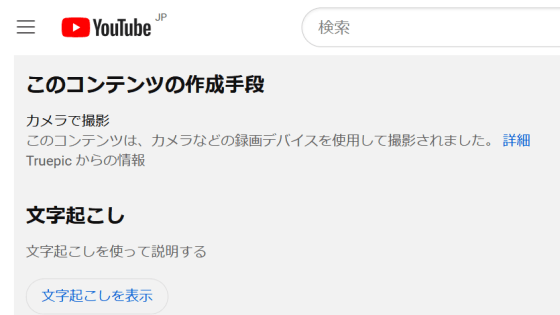'C2PA' that can tell whether it is AI-generated or live-action is automatically embedded in the photograph taken by Pixel 10 Review I checked various things, what information remains & how to erase
As image generation AI technology improves, it's becoming possible to create fake images so realistic they're indistinguishable from real photos.
Google Pixel 10 Series - Inspiration and AI in the Age of Creation
https://store.google.com/jp/category/phones?hl=ja
◆ Check the content authentication information of photos taken with Pixel 10
Content authentication information is automatically embedded in photos taken with the Pixel 10. The Google Photos app also supports reading content authentication information, making it easy to check the provenance of images.
To check the content authentication information for an image on your Pixel 10, open the image in the Google Photos app and swipe up.
When the image details are displayed, swipe up again.
At the bottom of the screen, content authentication information stating 'Taken with Google Camera' was displayed.
The image below is a photo taken with a Pixel 10 that has been edited using the Google Photos app, including cropping and adjusting the color temperature.
Checking the content authentication information reveals that the video was 'taken with a Google camera and edited with non-AI tools.'
![]()
◆Content authentication information can also be checked from a PC
You can check content authentication information not only on the Pixel device itself, but also in various apps that support C2PA. On a PC, the easiest way is to use
It's easy to use; just drag and drop the image you want to check the history of onto the screen.
As shown below, you can see that the photo was created on an Android device.
In addition, for photos taken with the Pixel 10 Pro's AI-powered 100x zoom feature '
◆ If the app supports C2PA, content authentication information will remain even after editing.
If you use a C2PA-compatible app like Photoshop, you can retain the C2PA information even after editing. As a test, I'll edit an image taken with a Pixel 10 and edited in the Google Photos app in Photoshop.
Embeds content authentication information when saving.
When the saved image was loaded into the official C2PA web app, content authentication information including the information 'edited in Photoshop' was displayed.
However, while the file name history remains, information such as 'taken with a Pixel' and 'edited with the Google Photos app' has been lost for the photos before they were edited in Photoshop. This appears to be due to differences in how companies respond to C2PA.
◆Content authentication information can easily disappear
C2PA has the characteristic that 'content authentication information disappears if edited with an app that does not support C2PA,' and with the current lack of C2PA-compatible apps, information can easily disappear.
As a test, I will try deleting the GPS information from photos taken with the Pixel 10 using the standard Windows function.
Because the Windows property editing function does not support C2PA, I intended to delete only the GPS information, but the content authentication information was also deleted.
While C2PA is certainly useful as a technology for verifying image provenance information, at the time of writing, there are few compatible apps, so the lack of content authentication information does not necessarily mean that it can prove that 'illegible editing has been performed' or 'image generation AI is being used.' For C2PA to be useful in the future, more compatible apps and devices will need to be added.
・Continued
The Pixel 10 series' 'My Voice Interpreter' is amazing, as it uses AI to reproduce your voice and automatically translate from Japanese to English during calls - GIGAZINE
Related Posts:





